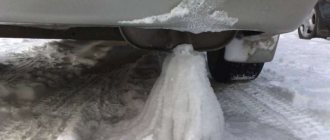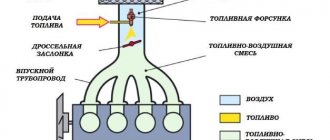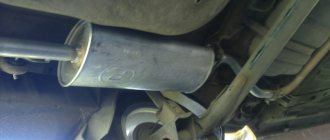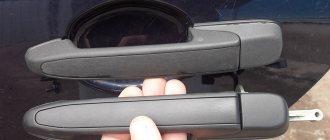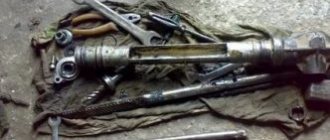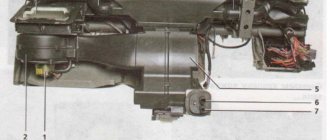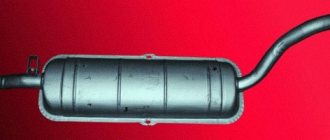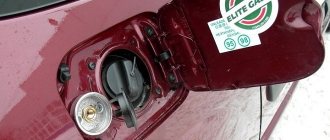In the practical Russian subcompact Lada Kalina, the exhaust system consists of several important components, among which there is undoubtedly a resonator. It is designed to ensure timely removal of combustion products from the working chambers of the cylinders. If the resonator functions correctly, then the motor is characterized by the ability to demonstrate the declared power indicator. In some cases, breakdowns occur and the resonator needs to be replaced, and sometimes the muffler needs to be replaced.
Differences between spare parts
Today on the market you can find an extremely large number of Kalina mufflers, the prices of which are too low. However, you need to understand how much an original spare part costs (to do this, just go to the official Lada website) in order to be able to distinguish between components made by hand. They will most likely last several times less than the original and, quite possibly, due to non-compliance with the technology, will even pose a danger to the life and health of the driver. Spare parts for model 1118 differ in the following parameters:
- material. The original spare part is made of aluminum or stainless steel. A product made of stainless steel will be quite difficult to find; they are often made to order. If the muffler is made of any other material, it is a fake;
- price. The cost of the original component is estimated at a thousand rubles or more, while fakes can cost less;
- weight. For the original it is higher than for the fake, since the real model is equipped with thicker walls and also contains a soundproofing layer;
The difference between the Kalina sedan, station wagon and hatchback muffler is that in the first and second models the product tube is curved, and the last model is equipped with a muffler with straight inlet and outlet pipes.
About the direct-flow system
Any car muffler reduces engine power by creating significant resistance to the flow of flue gases. This is the price you have to pay for comfort and an almost silent exhaust. But for motorists who are tuning their “iron horses”, there is an alternative option - a direct-flow type sound absorber.
The task of this element is to reduce power losses while continuing to absorb sound vibrations from engine operation. Forward flow is a compromise solution because, for the sake of power, it dampens noise not as effectively as standard car elements. What does this muffler consist of:
- metal body equipped with two pipes;
- inside there is a perforated straight pipe connecting the inlet and outlet;
- Between the body and the pipe there is a sound-absorbing material - kaolin or basalt wool.
Sounds traveling through a straight pipe with holes are partially absorbed by the fiber, but the other part passes out unhindered, because there are no partitions or resonance chambers. Therefore, cars equipped with forward flow make a rumbling sound, especially when you press the accelerator pedal.
The highest level of tuning is a combined exhaust system with a damper controlled from inside the car. With its help, the gas flow can be switched between two branches: the first has a conventional effective muffler, and the second has a forward flow. This allows you to use the power of the engine only when necessary, and under normal conditions, drive around the city without unnecessary “roar” from the exhaust pipe.
Manufacturers
Parts for Lada 1118 can be purchased from the following manufacturers:
- Lada . The AL category factory part has all the necessary characteristics for installation. It is made of aluminized steel, and the addition of silicon to the mixture only better protects the product from rust and improves resistance to temperature changes and aggressive chemical compounds. You can purchase such a part from official representatives of the company or in company stores;
- BalakovoRezinoTechnika. This Russian manufacturer, in addition to spare parts for domestic cars (VAZ, KamAZ, GAZ), is engaged in the production of rubber products as its main activity;
- Auto kit . This company operates in St. Petersburg and produces, in particular, roll-up mufflers for the VAZ 1118;
- Melitopol plant of automobile and tractor mufflers "UTAS". Engaged in the manufacture of exhaust gas systems. The company's assortment includes 150 types of products, including intake and exhaust pipes, mufflers for the VAZ 1118. The products produced are excellent for Moskvich, VAZ, MTZ, GAZ, ZAZ and many other brands of vehicles;
- SKS . The company's products meet the declared characteristics and have the required thickness and standard size. It is made, like the factory components, from aluminized steel, and can be installed along with the factory components of Kalina 1118;
- Polmostrow . The products of this Polish company include muffler models for the Kalina sedan and fully comply with the factory requirements of the domestic manufacturer. The design has seams that are welded automatically, which eliminates the appearance of unevenness and roughness. Rolling takes place along the tank of the product, which is done using German equipment. After manufacturing, the product undergoes technical control, testing, and only after that it is sent for sale.
Technical features of the insert for Lada Kalina 8V
The industry offers two types of tuning inserts, the design of each of them depends on the location of the pipes. Moreover, each design is designed for a specific power unit:
- Insert 4-1 is installed on forced engines with a speed range from 5,000 to 10,000 rpm. structurally suitable only for 16-valve engines.
- The 4-2-1 insert operates over a wider range and is considered a "low-end" insert. It is possible to increase engine power by about 3-5%. This is the model most often installed on the VAZ 1118.
Since it will not be possible to install a preliminary flame arrester on this VAZ car, you will have to carefully approach the issue of choosing an insert. The installation process of the part will not take much time if you follow all the recommendations.
Features of replacing parts
After replacing the muffler on Kalina, in rare cases you may encounter the following problems:
After approximately 3-4 years of operation of the car, some elements of its exhaust become unusable. Of course, in this case we are not talking about foreign cars, but about cars from a domestic manufacturer. Why does the muffler fail so quickly? It's simple: firstly, it is usually made from low-quality metal, and secondly, constant exposure to various external factors contributes to the very rapid development of corrosion.
Be that as it may, in this article we will consider not the reasons for the rather rapid wear of the exhaust system, but the process of replacing its main elements: an additional muffler and a catalyst. An important point: the instructions for doing the work yourself are valid for Lada cars of the Kalina, Priora, Grant models.
Malfunctions
The following signs indicate a muffler malfunction:
- the engine makes a growling sound;
- Exhaust gases enter the interior from under the bottom of the car, which is easily determined by the smell.
The main causes of muffler malfunction:
- water, it causes corrosion in the muffler and, over time, holes form in it;
- a sharp change in temperature leads to the formation of condensation;
- mechanical damage (impacts from the muffler due to its low location);
- shaking on the roads leads to disruption of connections;
- muffler burnout.
When malfunctions occur, a problem arises - repair or replacement? In any case, measures must be taken, otherwise the powerful roar of the car will disturb others, get on the owner’s nerves and attract the attention of traffic police officers. If there is no experience in repair work, or the muffler is seriously damaged, then it is worth replacing it
If there is no experience in repair work, or the muffler is seriously damaged, then it is worth replacing it.
Replacing the muffler on Lada Kalina
The easiest way to replace a worn muffler is in the inspection hole. The main and additional mufflers are connected to each other by means of a metal clamp. To dismantle it, you will need two 13mm spanners or wrenches. With one wrench we hold the bolt nut, preventing it from turning, and with the second we unscrew it. After the bolts are unscrewed and removed, carefully remove the clamp.
Next, move the exhaust pipe of the muffler back a little and remove the connecting gasket (connecting ring). Then we move the exhaust system pipe to the rear suspension beam.
Now we remove the muffler mounting bracket from the first shock-absorbing rubber pad. Then, using a small pry bar, remove the muffler from the second cushion. We remove it, carefully removing it from under the rear suspension beam.
Exhaust system
Exhaust gases are discharged from the engine through exhaust pipe 1, Figure 22, of the muffler with neutralizer assembly, additional muffler 8 and main muffler 10. A sealing gasket 20 is installed between the flanges of the exhaust pipe and the additional muffler. There is a vibration compensator on the pipe of the additional muffler. The pipes of the main and additional mufflers are connected to each other by flared ends using a clamp 13 with an intermediate ring 14. The gas exhaust system is attached to the car body using muffler suspension cushions 9 and 11.
Figure 22 — Exhaust system:
- muffler intake pipe with neutralizer assembly
- washer 8
- M8 nut
- oxygen concentration sensor
- exhaust pipe bracket clamp
- washer 8
- M8 nut
- additional muffler
- muffler suspension cushion
- main muffler
- muffler suspension cushion
- bolt M8x65
- connecting clamp
- ring sealing
- washer 8
- M8 nut
- muffler mounting nut
- locking plate for the nuts securing the exhaust pipe of the muffler
- lower exhaust pipe screen
- muffler flange gasket
- bolt M8x16
- spring washer 8
- washer 8
- exhaust pipe bracket assembly
- gas pipeline laying assembly
Removal
Place the vehicle on a lift and apply the parking brake. Open the hood and disconnect the negative terminal from the battery (electrohydraulic lift type PV-3-T-SP, lifting capacity 3 tons, wrench 10).
Disconnect the sensor harness connectors 4, Figure 22, oxygen concentration.
Unscrew the upper oxygen sensor on the exhaust pipe 1 of the muffler with the neutralizer assembly (wrench 22).
Raise the car to a height convenient for work, unscrew two nuts 16 bolts 12 of the clamp 13 connecting the main muffler with the additional one, remove the clamp and sealing ring 14 (ring wrench 13, wrench 13).
Remove the muffler suspension cushion 9 from the front bracket of the main muffler and remove the main muffler 10 (using a flat-head screwdriver).
Unlock and unscrew three nuts 4, Figure 23, of the studs securing the additional muffler 5 to the exhaust pipe 1 with the neutralizer assembly, remove the nut locking plate and the lower exhaust pipe shield 2 of the muffler (flat screwdriver, replaceable head 13, extension and ratchet wrench).
Figure 23 — Connection of the exhaust pipe of the muffler with the neutralizer assembly and the additional muffler:
- muffler intake pipe with neutralizer assembly
- lower exhaust pipe screen
- muffler flange gasket
- muffler mounting nut
- additional muffler
Remove the additional muffler 8, Figure 22, assembled with suspension cushions 9 from the body brackets and gasket 20 of the muffler exhaust pipe flange (flat-head screwdriver).
Unscrew the two nuts 7 securing the clamp 5 of the exhaust pipe bracket and remove the bracket clamp (replaceable head 13, extension and ratchet handle).
Unscrew the seven fastening nuts 3, disconnect the exhaust pipe 1 of the muffler with the neutralizer assembly from the cylinder head and remove the exhaust pipe downwards, remove gasket 25 of the gas pipeline. The nuts of the studs securing the exhaust pipe to the cylinder head must be replaced (wrench 02.7812-9500 or replacement head 13, extension and ratchet wrench).
Installation
Install gas pipeline gasket 25, exhaust pipe 1 of the muffler with the neutralizer assembly and tighten the seven nuts 3 of the studs securing the exhaust pipe to the cylinder head.
Lada Kalina is considered a practical and affordable vehicle for use in families and businesses. However, a domestically produced car can cause its owner many problems, since not all elements of its systems are “brought to perfection.” One of the problematic parts of the car can be considered the muffler. However, its structure and fixation are such that the car owner can carry out all the work on diagnosing and replacing it himself.
Replacing the resonator yourself
As when replacing the main muffler, to replace the resonator we will need to remove the mounting clamp. To do this, use two 13mm wrenches to unscrew the bolts that tighten it. By the way, if due to severe corrosion it is impossible to unscrew the bolts, you can go another way: cut them off using a grinder and subsequently replace them with new ones.
The resonator is bolted to the catalyst with two bolts. Before unscrewing, it is recommended to treat them with WD-40 and tap them with a hammer. After the nuts have loosened, use two wrenches to unscrew the bolts securing the resonator to the neutralizer. An important point: do not unscrew the nuts completely. If the car does not have a neutralizer, unscrew the bolts securing the resonator to the exhaust pipe.
Next, carefully lift the resonator and remove the rear rubber cushion from it, and then the front one.
After this, holding the resonator, finally unscrew the nuts and remove the spring washers. Remove the bolts and dismantle the resonator.
Installing a new resonator is done in the reverse order.
It should be noted that in case of severe corrosion of the mounting bolts, clamp and the resonator itself, a somewhat non-standard method can be used: the faulty unit is cut off using a grinder from the corrugation to the main muffler. The new resonator is installed in place of the old one using electric welding.
Resonator device
Structurally, the resonator consists of a perforated (drilled along the entire length within the device) pipe placed in a metal casing. The design also has a throttle hole designed to increase the efficiency of damping wave vibrations in the pipe. The internal cavity of the resonator is divided into two or more unequal parts by partitions located in a transverse plane to the pipe. Also, more modern exhaust resonators are designed with thermal insulation and/or sound insulation (often the same material) located under the housing and designed to reduce its temperature and/or sounds emanating from the device.
Internal structure of the resonator
The internal cavities have an unequal volume in order to ensure periodic narrowing and expansion of the flow of exhaust gases, which in turn equalizes their uneven pulsation. That is, each chamber has its own resonant frequency. In addition, they have a slight offset relative to the axis of the body. This is necessary to achieve a change in the direction of the exhaust flow. And internal perforation on the pipe is needed to dampen the large amplitude of sound waves that produce gases.
The efficiency of the resonator is influenced by the following factors:
- the degree of its wear, tightness;
- level of contamination from soot (the cleaner, the more effective);
- diameter (the larger the diameter of the device, the greater its efficiency).
Replacing the resonator Lada Kalina
The car became painfully loud. The muffler was new (see how to replace it here), but I still decided to crawl under the car and check the tightness of the entire exhaust system. It turned out that the resonator pipe (additional muffler) was rotten in the place between the main and additional mufflers.
In such a situation, the resonator must be replaced. To replace the resonator on Kalina, it must be removed (this is obvious). To do this, you will have to unscrew three nuts securing it to the exhaust manifold and 2 nuts of the clamp connecting the resonator to the main muffler. The work is best done from the pit.
The task at first glance is simple, but there is one “but” - the nuts on the manifold could become very stuck and it will be very difficult to unscrew them. Spray them with WD-40, use strong wrenches. For convenience, you can remove the engine protection.
After everything is unscrewed, remove it from the hangers and pull it out. The resonator itself was in good condition, but the two elbows going to the clamp were rotten. Therefore, I decided not to spend money and buy a new one, but to try to solve the problem with the help of welding and a grinder. If things are much worse for you or you just don’t want to fool your head, then buy a new resonator and install it in the reverse order (you don’t have to read further).
Why did it happen so?
Perhaps the automatic requests do not belong to you, but to another user accessing the network from the same IP address as you. You need to enter the characters into the form once, after which we will remember you and be able to distinguish you from other users exiting from this IP. In this case, the page with the captcha will not bother you for quite a long time.
You may have add-ons installed in your browser that can make automatic search requests. In this case, we recommend that you disable them.
It is also possible that your computer is infected with a virus program that is using it to collect information. Maybe you should check your system for viruses.
If you have any problems or would like our support team, please use the feedback form.
Lada Kalina is considered a practical and affordable vehicle for use in families and businesses. However, a domestically produced car can cause its owner many problems, since not all elements of its systems are “brought to perfection.” One of the problematic parts of the car can be considered the muffler. However, its structure and fixation are such that the car owner can carry out all the work on diagnosing and replacing it himself.
Exhaust system "Lada Kalina"
After processing the air-fuel mixture, residual substances must be released from the engine cavity. An exhaust system is used for these purposes. Without it, operating any car is simply impossible.
The exhaust system of the Lada Kalina car consists of several elements:
- an exhaust manifold;
- exhaust pipe;
- main muffler;
- additional;
- catalytic converter.
All parts of the exhaust system not only allow you to safely and quickly remove exhaust gases from the engine, but also reduce noise levels . And the neutralizer serves to reduce carbon monoxide emissions, that is, it reduces the toxicity of exhaust on the Lada Kalina.
It should be noted that the mufflers for Lada Kalina sedans, hatchbacks and station wagons will be slightly different. Thus, the device labeling must fully comply with the VAZ labeling. For example, VAZ-1117 (Lada Kalina hatchback) requires model 1117, and VAZ-1118 (Lada Kalina sedan) requires muffler 1118. For the Lada Kalina station wagon modification, a device marked 1118-1200010 is installed.
Exhaust system of VAZ-2110
Exhaust system
a – without converterab – with converterb – exhaust gas flow diagram1 – exhaust pipe mounting bracket2 – gasket3 – exhaust pipe4 – muffler suspension cushion5 – additional muffler6 – muffler pipe connection clamp7 – main muffler8 – rear muffler suspension cushion9 – oxygen sensor (lambda probe)
10 - three-component neutralizer11 - additional muffler housing12 - inlet perforated pipe13 - blind partitions14 - exhaust perforated pipe15 - main muffler body16 - left perforated pipe17 - front blind partition18 - middle blind partition19 - rear blind partition20 - rear perforated pipe21 - right perforated pipe
The exhaust system consists of an exhaust manifold, a exhaust pipe 3, an additional 5 and a main 7 muffler. The exhaust manifold and exhaust pipe mounting bracket 1 for 8-valve engines (2110 and 2111) are interchangeable with parts from Samara. The exhaust system of the 2112 engine is distinguished by an exhaust manifold and a downpipe.
On most cars equipped with an injection system, the exhaust pipe is equipped with an oxygen sensor (lambda probe). A three-component neutralizer is additionally installed in the exhaust system of these vehicles. Mufflers and neutralizer are non-separable units and when they fail, they must be replaced with new ones.
The exhaust manifold is cast from cast iron. A metal-reinforced heat-resistant gasket is installed between it and the cylinder head. The exhaust pipe is attached to the exhaust manifold on four studs (for the 2112 engine - on six). The connection is sealed with a heat-resistant gasket. The receiving pipe is made of stainless steel. It is attached to the power unit using a bracket with a clamp covering both outlet pipes.
The exhaust pipe is pivotally connected to the pipe flange of the additional muffler or neutralizer (for models where it is provided). Between the flanges there is a metal-graphite ring with a spherical outer surface. The inner surface of the flanges is also spherical, and they are tightened with spring-loaded bolts, which allows the muffler pipe to move (without losing its tightness) relative to the exhaust pipe when the power unit oscillates relative to the body.
To reduce noise and better thermal insulation of the body, the additional muffler has a protective cover. For vehicles with a neutralizer, an additional muffler is available with a shortened front pipe.
The neutralizer is designed to reduce emissions of carbon monoxide, nitrogen oxides and unburned hydrocarbons into the atmosphere. For this purpose, two ceramic blocks with many pores, coated with so-called afterburning catalysts: rhodium, palladium, platinum, are used. Passing through the pores of the neutralizer, carbon monoxide is converted into low-toxic carbon dioxide, and nitrogen oxides are reduced to harmless nitrogen. The degree of gas purification in a working neutralizer reaches 90-95%. For normal operation of the converter, the composition of the exhaust gases (in particular, the oxygen content in them) must be within strictly specified limits. This function is performed by the controller, determining the amount of fuel supplied depending on the readings of the oxygen sensor
The neutralizer and oxygen sensor are very sensitive to lead compounds - both of them are quickly “poisoned” and stop working, which, accordingly, leads to an increase in emissions of toxic substances. Therefore, if your car is equipped with a neutralizer, its operation, even short-term, on leaded gasoline is strictly prohibited. A faulty ignition system can also cause the neutralizer to fail. If sparking is missed, unburned fuel enters the converter, burns out and sinteres the ceramics, which can lead to complete blockage of the exhaust system and engine shutdown (or severe loss of power).
The main muffler is located after the additional muffler and is connected to it using an O-ring with clamps (as on the Samara). The mufflers are suspended from the body brackets on four rubber pads.
HdSxozARNdCZoZ0rmlIZmTSTN29TNdkrbraqebaqo3I5Ndk9etIUo3AwmLs6nl5wnl5SFlEwN2GVh4OUMDIuhRk4gDA4h3QSnlOuOBu0gBAypbefebaqebAsmLIQFlCsFlGwnlKxOB0rm2cWoDKrF JcZgBk2hJgZgBm4GJszhBarbraqebaqMdC0mj1QMb1ZNd90HjeZhBi4hBq0gZg4eR48F2SxoZ4=
What does the muffler consist of?
The main part of the exhaust system serves to absorb noise. On the Lada Kalina car, this function is performed by a pipe, which includes the muffler itself and its resonator.
The thickening is the resonator, the end is the muffler itself
The pipe has a completely sealed body, which is manufactured using the rolling method, that is, without the use of a welding machine. Thanks to this, the muffler is durable and does not corrode. And the resonator, which is also located in the pipe, consists of several closed chambers. These chambers are connected to each other by small tubes with holes in them. Thanks to this structure, the resonator can quickly smooth out all acoustic vibrations. In the latest modifications of the Lada Kalina, the inside of the resonator is lined with sound-absorbing material.
The three-chamber device allows you to reduce the noise level in the car
Unfortunately, the quality of mufflers for Kalina leaves much to be desired. Often their service life does not exceed 40–50 thousand kilometers. Therefore, the car owner has to think about which “gluker” to choose. Today, mechanisms for the Lada Kalina are presented at a variety of prices - from the cheapest to the most expensive. However, it is better to navigate the world of auto parts using the following parameters:
- muffler material: original spare parts are made of stainless steel or aluminum, they will last as long as possible and ensure high-quality exhaust removal;
- cost: you should not purchase a device below the 1 thousand ruble mark;
- weight: an original and high-quality “glushak” will weigh more than a fake, since the chambers are equipped with thicker walls and sound-proofing materials.
Design and principle of operation
There are 4 ways to suppress powerful sound impulses implemented on various vehicles:
- noise limitation;
- reflection;
- resonant noise suppression;
- absorption.
A limiting device is the simplest version of a muffler, used on some tractor models. The element is a tapering pipe placed inside a metal tank. The disadvantages of the product are obvious - noise is partially suppressed, and engine power is noticeably reduced.
Mirror elements are installed on motorcycles and scooters. The principle of operation of the muffler is as follows: gases from the exhaust elbow enter the reflective can, change the direction of movement and are thrown out. Due to reflection, sound vibrations are dampened and the noise level is reduced. The part works successfully with two-stroke engines, but its efficiency is not enough for a car.
The third method is implemented in automobile resonators. Inside the steel tank there are several partitions, and between them there are resonance chambers connected by steel tubes. Smoothing of noise pulses is achieved due to two factors:
- Gases and sound waves change direction several times, reflecting from the partitions.
- The dimensions of the chambers and pipes are designed in such a way that the frequency of sound vibrations coincides. Then the waves are damped due to the resulting resonance.
It must be understood that the resonator design is not universal for all machines. Cars are equipped with engines of different power, producing noise of different amplitudes and frequencies. The sound absorber is developed separately for each make and model of car.
A cross-section of a car muffler operating on the principle of noise absorption is shown in the diagram.
As in the resonator, partitions and jumpers in the form of tubes are installed here. Only in the latter are many holes of different diameters (perforation) made, and non-flammable absorbing material is laid on the sides. As a rule, basalt or kaolin wool is used for these purposes, which can easily withstand gas temperatures of 600–700 °C.
Sound waves, passing through adjacent pipes with holes, are partially scattered and damped by overlapping each other. The second part of the vibrations is absorbed by the filler, and the third is smoothed out due to partitions and a change in the direction of flow.
How to determine whether the muffler is faulty on a Lada Kalina
Domestic cars have a simplified exhaust system design. Thanks to this, the driver can easily determine malfunctions in the operation of the Lada Kalina muffler.
First of all, it is necessary to clarify exactly what risks are possible when using a faulty device:
- If a hole has formed in the plug, toxic gases can enter the cabin. The danger is that the exhaust gases are colorless and odorless. After even a short period of inhalation, the driver may feel headache, nausea and fatigue;
- If the system mechanism fails, loud popping noises in the resonator will immediately be noticeable. And today, many city districts and entertainment establishments limit the noise level on their territory, so the driver of a car can receive a fine;
- decreased comfort while traveling, since the noise level with a faulty muffler will not allow you to talk or listen to music.
Malfunctions can be determined independently. This does not require any special knowledge or equipment.
It is important that the muffler is always in a strictly horizontal position
Step-by-step instructions for diagnosing a malfunction
Proceed in the following order:
- Listen carefully to the noises that arise when the car is moving. If the muffler is faulty, the car will run much louder than before. And also knocking or a characteristic gurgling sound while driving indicates a breakdown in the exhaust system.
- Raise the car on a jack and inspect the body of the device. There should be no holes or even ordinary rust on it. If there are already rust marks on the case, then most likely there are also some defects inside the case.
- When driving, carefully monitor the quality of the exhaust gases. If black and dense smoke periodically escapes from the muffler, then there is definitely something wrong with the exhaust system.
- Start the engine and rev it up for a few minutes. Then turn off the ignition and check the engine temperature. After a short period of operation, the motor should not have time to heat up. If there is overheating, it means that the mechanism is not doing its job.
How does a resonator work and its functions?
As mentioned above, the exhaust system includes a resonator. In a resonator, each of the constituent components has its own role. The main purpose of this unit is to dampen low-frequency sounds generated during the intensive movement of the exhaust gas stream inside the muffler circuit. Sounds of this nature occur for the following two reasons:
- from the effect of gas expansion;
- due to vibrations of components in the muffler line.
An important function of the resonator unit is reducing the speed of movement of the gas jet. Here fundamental physical laws come into play, indicating the inevitable damping of speed during the transition of a gas mass from a thin pipe into a volumetric cavity. It is precisely to achieve this effect that the design concept of the resonator is designed.
It is precisely to achieve this effect that the design concept of the resonator is designed.
In the exhaust gas circuit, the resonator component is located in front of the main muffler, thereby being the primary link in the chain of damping low-frequency sounds.
Structurally, the product assumes the presence of a perforated section of pipe inside the metal body, where there is a throttle-type hole, designed to effectively dampen vibrations arising from the movement of the gas jet. The internal space of the housing has partitions that are oriented transversely to the perforated pipe. Now you have an idea of what an exhaust system is.
In comparison with the resonators in the exhaust circuits of other models, this unit in the Lada Kalina has a corrugated element. The design necessity is due to the tendency of the device to move during the heating of the gas exhaust jet.
The manufacturer makes all resonator components only from high-quality steel. Otherwise, the car's exhaust system would constantly require repair work. But sometimes it is still necessary to replace the resonator, and in some cases, replace the muffler.
How to replace the Lada Kalina muffler with your own hands
Before we talk about replacing the muffler, you need to choose the right model. The device is matched to the car body. At the same time, it is best to purchase “Glushak” not at car markets, but in specialized stores. You can buy a model on the market for 500 rubles, but it is unlikely to last long. When in a car shop you can pick up an aluminum or stainless steel muffler housing for 1000–1500 rubles and be sure of its long service life. Typically, original exhaust system elements last for 50 thousand kilometers.
To successfully complete all procedures, it is best to immediately prepare the following tools:
- WD-40 lubricant;
- two open-end wrenches for 13;
- hammer;
- flat blade screwdriver.
Video: DIY replacement of the silencer
Dismantling procedure
Removing the resonator and plug can be considered the most labor-intensive part of the entire replacement procedure. The complexity is determined by the fact that it can be very difficult to disconnect the elements of the exhaust system from each other:
- The first step is to jack up the rear of the car or drive it into a hole.
- Then you will need to find the connecting clamp that connects the muffler and the resonator. It will be difficult to remove the clamp, since the bolted connections stick to the metal structures due to constant heating.
- It is best to first lubricate all connections with lubricating fluid and then proceed with removal.
- After dismantling the resonator, you need to remove the muffler itself.
- It is usually easily removed, since it is attached to the bottom of the car using rubber hangers.
It is recommended to immediately remove all stickers and wrapping from a new product.
Therefore, removing the muffler may take about 20-30 minutes, depending on how difficult it is to remove the resonator bolts. In this case, all connecting elements and seals must also be removed - their further use on the new device is impossible.
The described operating procedure will be the same for all modifications of the Lada Kalina, regardless of body type.
How to change seals, rubber bands and corrugation
There are usually no problems when it comes to changing o-rings and rubber bands on the muffler. All components can be purchased along with the device and rubber bands can be put on in place of the old ones.
The rubber band for the silencer is inexpensive and can be changed in a minute.
Replacing the corrugation is considered a more complex procedure. In addition, the car owner does not always have a welding machine at hand and knows how to operate it.
To change the corrugation on a still working muffler, you must perform the following steps:
- Using a grinder, cut off the remnants of the old corrugation (of course, the muffler will need to be removed before doing this).
- On the new corrugation, neat cuts are made in those places to which the pipes will be joined.
- The corrugation is pulled into place and must be fixed on both sides with clamps.
- “Glushak” is installed under the bottom.
This simplified method of replacing the corrugation is considered quite practical, although, of course, welding work would make the replacement more durable.
Corrugation element increases muffler service life
Checking the resonator
When identifying the problems listed above, every motorist should know how to check the resonator . This will not only normalize the operation of the engine and exhaust system, but also increase the comfort of using the car, including for the people around you.
To check, you will need an inspection hole (if you don’t have one, you can jack up the car). Diagnosis is made using visual inspection. During the process, it is necessary to carefully examine the integrity of both the device itself and the pipes connected to it (especially at their joints).
A clear sign of a problem is the formation of condensation in the cooling resonator, after which it begins to drip to the ground. This means that its body has lost its tightness and must be repaired, or better yet, replaced. You can check for condensation after some time, when you turn off the engine (to allow the resonator body to cool). Note! Some car enthusiasts, when making resonators on their own, specially drill a hole in its body to remove moisture . Therefore, if you bought a car with a similar resonator, then this testing method will not work for you.
How to install a new muffler on the Lada Kalina
The installation procedure will take no more than five minutes. Since all the elements are new, you won’t have to deal with rust and corrosion. The installation procedure looks like this:
- First, the device itself is installed - two rubber hangers are used for this.
- The resonator is mounted in place of the old device with 13 bolts.
- The connection between the muffler and the resonator is secured with new clamps.
- After which you can remove the car from the jacks and check the functionality of the device.
Table: tightening torques for threaded connections
| Name of units and parts | Thread | Tightening torque, nm (KGS-M) |
| Nuts for fastening the exhaust manifold Nut for fastening the exhaust pipe to the exhaust manifold Nuts for the clamp bolts securing the flanges of the main and additional mufflers Bolts for the converter flange and exhaust pipe Bolts for the catalytic converter bracket | M8 M8x1.25 M8x1.25 M8x1.25 M8 | 20,9–25,8 (2,1–2,6) 20,9–25,8 (2,1–2,6) 15,9–22,6 (1,6–2,3) 15,7–22,6 (1,6–2,3) 14,0–18,0 (1,4–1,8) |
Lada Kalina cars can be quite capricious in terms of wear and tear on exhaust system elements. However, the short service life of mufflers can be prevented by choosing a quality product and carrying out installation work yourself, since only in these cases can you be sure of the long-term operation of the muffler.
Similar products from other companies
- Air filter Sintec (Sintek) SNF-2413-b for foreign cars Hyundai (Hyundai) i40/ix35, KIA Sportage (KIA Sportage) 3 121 b
- Air filter Sintec (Sintek) SNF-2405-b for foreign cars Chevrolet Aveo (Chevrolet Aveo), Daewoo Kalos (Daewoo Kalos) engine 1.4/1.4l 16v/1.6 98 b
- Air filter Sintec SNF-1015-b for foreign cars Ford Tourneo, Transit 92/95, Volvo 440/460/480 98 b
- Air filter Sintec (Sintek) SNF-3466-b for foreign car Hyundai (Hyundai) County/hd65/72 engine Euro-3 433 b
- Air filter Sintec (Sintek) SNF-lr002/1-b panel original for foreign car Renault Logan (Renault Logan) 162 b
- Air filter Sintec SNF-1266-b for foreign cars Opel Astra g/h, Zafira |/||, Saab 9-3, for VAZ, Niva Chevrolet 1.8 i 16v 84 b
- Oil purification filter Sintec (Sintek) SNF-75/3-m for VAZ LADA Largus (LADA Largus), for foreign car Renault Logan (Renault Logan) 112 b
- Air filter Sintec (Sintek) SNF-lr003-b trapezoid for foreign car Renault Logan (Renault Logan) 165 b
- Air filter Sintec (Sintek) SNF-luxtr104р-b for GAZ high engine ZMZ 406, Steyr (Steyer) 560 209 b
- Air filter Sintec (Sintek) SNF-2110-v (EKO-102 for VAZ injection engine, LADA Kalina (Lada Kalina), LADA Priora (Lada Priora), for foreign car Audi (Audi) 94 b
- Air filter Sintec (Sintek) SNF-2101-v (EKO-101/1) for VAZ, for Moskvich, for ZAZ Tavria carburetor engine 62 b
- Air filter Sintec (Sintek) SNF-402-v 103/1 for GAZ carburetor engine 111 b
- Sintec oil filter SNF-5540-m for foreign car Hyundai County/hd65/72/78 d4al/db/dd 211 b
- Air filter Sintec (Sintek) SNF-luxtr105p-b for GAZ low 183 b
- Air filter Sintec (Sintek) SNF-2409-b for foreign cars Hyundai (Hyundai) i-30, KIA Ceed (KIA Sid) 98 b
- Air filter Sintec SNF-1019-b for foreign cars KIA Carens 2/3, Cerato, Shuma 1/2, Sorento 2.4 83 b
- Oil purification filter Sintec (Sintek) SNF-2105-NF-05-m for VAZ 2110-2115 injection engine 104 b
- Oil purification filter Sintec (Sintek) SNF-2101-NF-01-m for VAZ, for Moskvich, for UAZ 107 b
- Oil purification filter Sintec (Sintek) SNF-3105-m for GAZ 3102 Volga engine injection, for GAZ 2705 GAZelle, Sobol 117 b
- Air filter Sintec (Sintek) SNF-lr001-b round for foreign car Renault Logan (Renault Logan) 148 b
The description and image of goods on the website are for informational purposes only and may differ from the actual description, technical documentation from the manufacturer and the actual appearance of the goods. We recommend checking the availability of the desired functions and characteristics of the goods with the seller.
If you did not find what you were looking for on the page or want to find additional information on your request, try using the search form or follow the links to the following sections:
- Spare parts for passenger cars, auto parts
- Mufflers, exhaust system parts and accessories for passenger cars
- Muffler clamps for passenger cars
Types of automotive resonators
When choosing an exhaust system resonator, you need to know what types they are and what materials they are made from. Currently, automotive resonators made of aluminized steel and stainless steel . The former are distinguished by their low price, but short service life. Their body is made of thin steel, coated with aluminum on top to prevent corrosion. However, this anti-corrosion composition is not durable. Therefore, we do not recommend that you buy an exhaust resonator made of aluminized steel. It is better to buy a car resonator made of stainless steel. This material has a smoother surface (that is, creates a minimum of turbulence in the system), and is also more resistant when working under extreme temperatures.
Let's sum it up
The problem of replacing the resonator unit can equally likely befall both the owner of the new LADA Kalina and the owner of the sedan or station wagon version of the car that has been in battles. In this case, we do not recommend postponing the repair procedure, since the failure of one of the components of the exhaust circuit can most likely provoke rapid wear of another element. As a rule, owners are faced with the fact of burnout. This situation will inevitably lead to an increase in the cost of repairs, because replacing a muffler costs much more.
Also, the owner of a sedan or station wagon should remember the need for periodic preventative inspections of the exhaust gas circuit. This will not only prevent the development of negative consequences, but also promptly identify shortcomings, which will allow them to be quickly eliminated.
Replacing the muffler on KALINA | How to replace the muffler [KR | TheReisenderHell]
